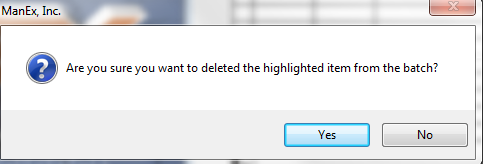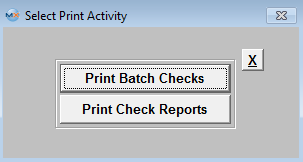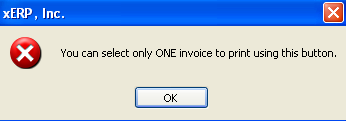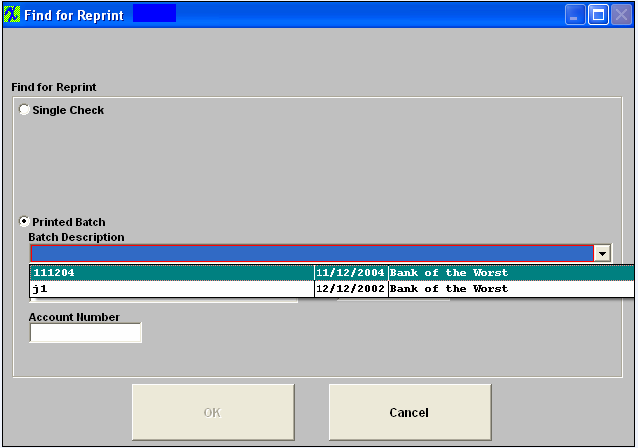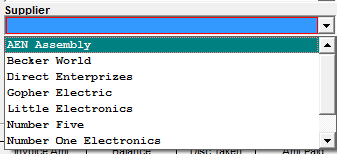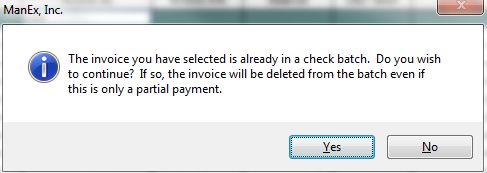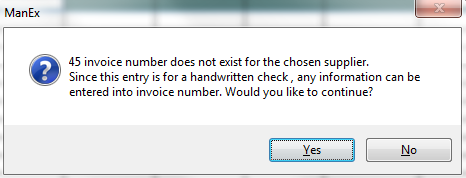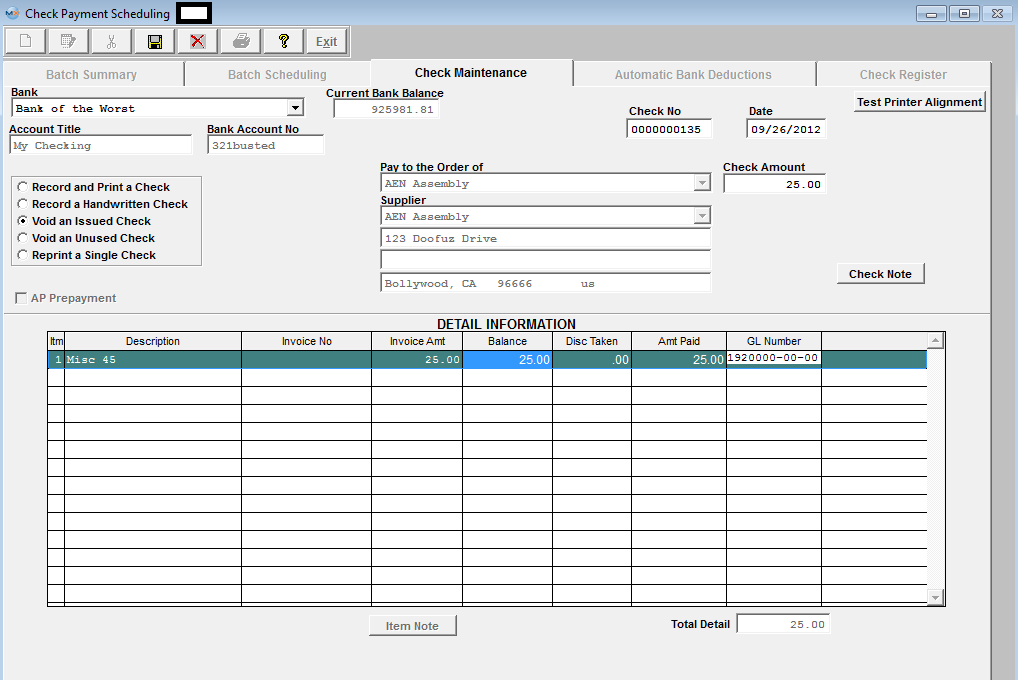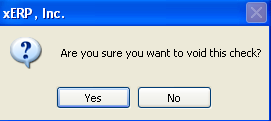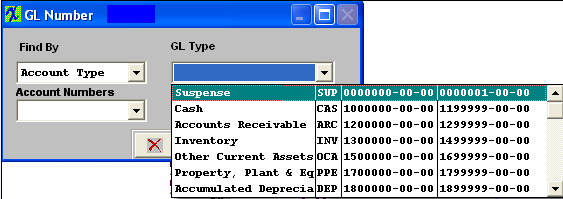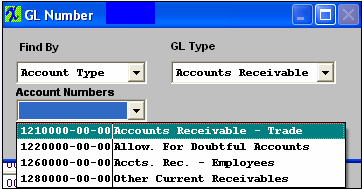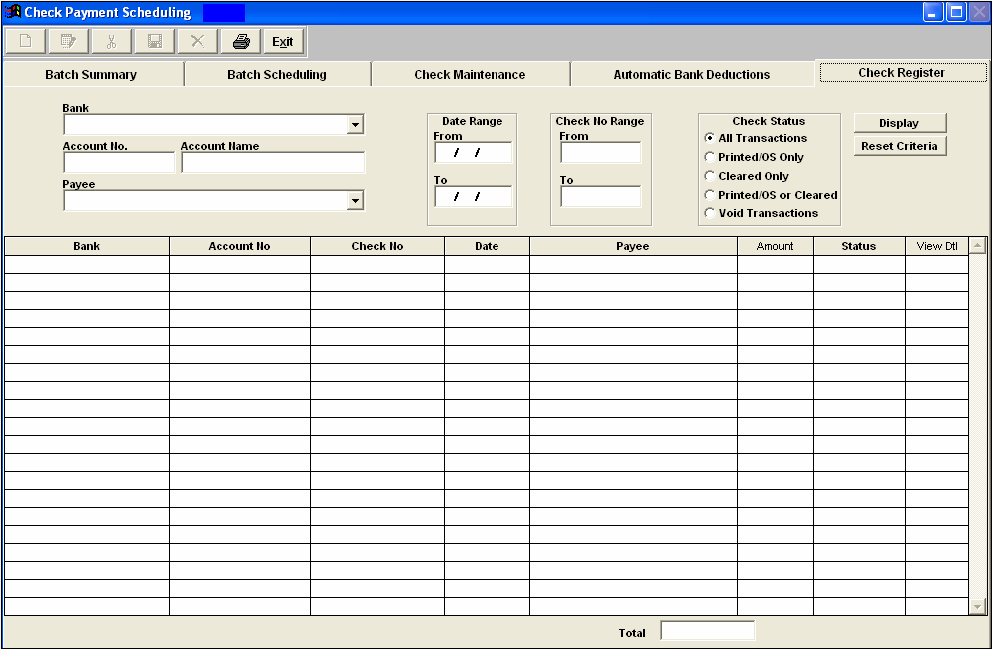| 1. How To ..... for Payment Scheduling |
| 1.1. Batch Scheduling |
| 1.1.1. Create a Scheduled Batch of Checks | ||||
Adding a New Scheduled Batch
The following screen will be displayed:
Enter the Batch Scheduling screen: Depress the Add record button. Select the Bank Name from the drop down display (Inactive Bank Accounts will not be listed). The Account Title and Number will appear automatically. Enter in the Scheduled Date. Enter in the Batch Description. Select your Payment type. Select the appropriate radio in the "Items to Display" section: "Earn Discount by Date", "Due By date" or "All Unpaid". If "Earn Discount by Date" or "Due by Date" are selected the date through which you want included in the scheduled batch must be enter into the "To Date" field. Then depress the Display button.
All unpaid Invoices will be displayed:
|
| 1.1.2. Edit a Scheduled Batch of Checks | ||||
The following screen will be displayed: To edit a scheduled batch, highlight the batch you want to edit. Go to the Batch Scheduling screen.
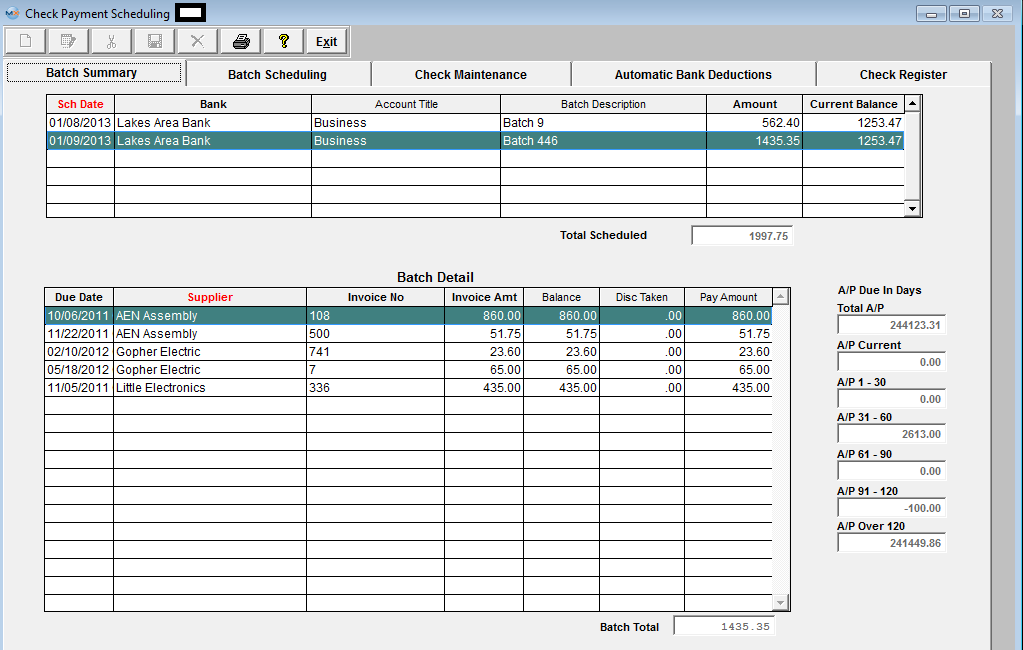 Depress the Edit button. Enter your password. If you want to add to this batch, depress the Add items button at the botton of the screen. Enter the EXACT invoice number as is entered in the Accounts Payable Aging. Depress the Enter Key and the rest of the information regarding that invoice will fill in automatically. 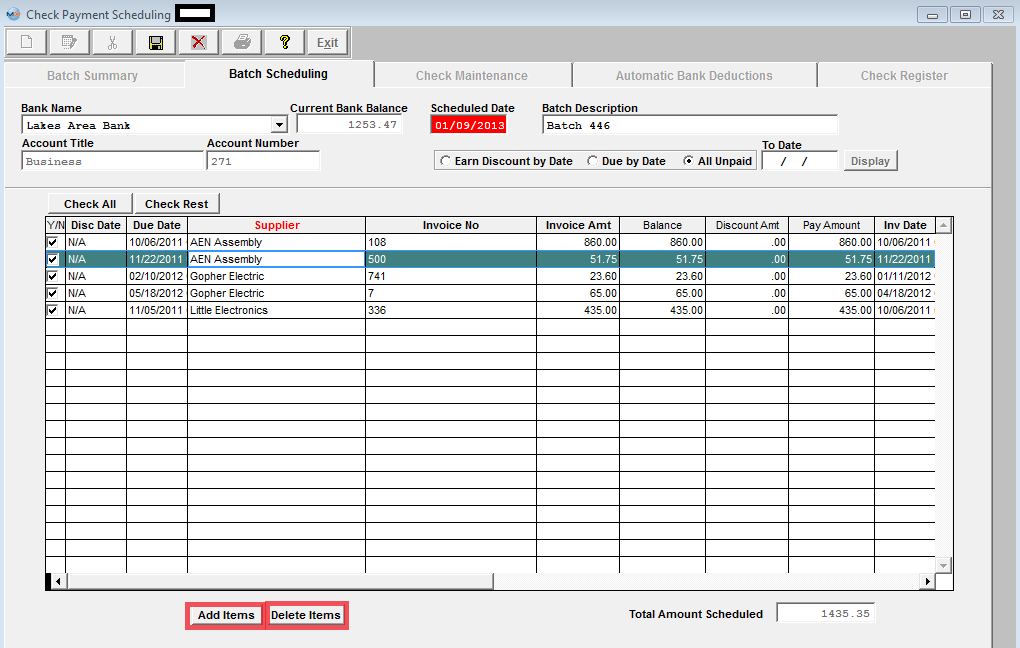 To delete an already scheduled line item, highlight the item. Depress the Delete Items button. You will receive the following message: Depress the Yes button to continue, depress the No button to abondon deletion.
Depress the Save button to save the changes, depress the Abandon changes button to abandon the changes.
|
| 1.1.3. Delete a Scheduled Batch of Checks | ||||
The following screen will be displayed: Highlight the batch you want to delete.  Enter the Batch Scheduling screen. Depress the Delete Batch record button.
 Enter in your password. The following message will appear:
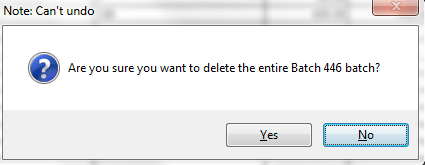 Depress the Yes button to continue. The batch will be deleted. Enter the No button to abandon the deletion. |
| 1.1.4. Printing Batch Checks | ||||||||||||||||||||||||||||||||||||||||||||||||||||||
The following screen will be displayed: Highlight the batch you want to print. 
If the user selects the "Print Batch Checks", the following screen will appear: (Note: The Bank name field could be blank if the Bank is Inactive)
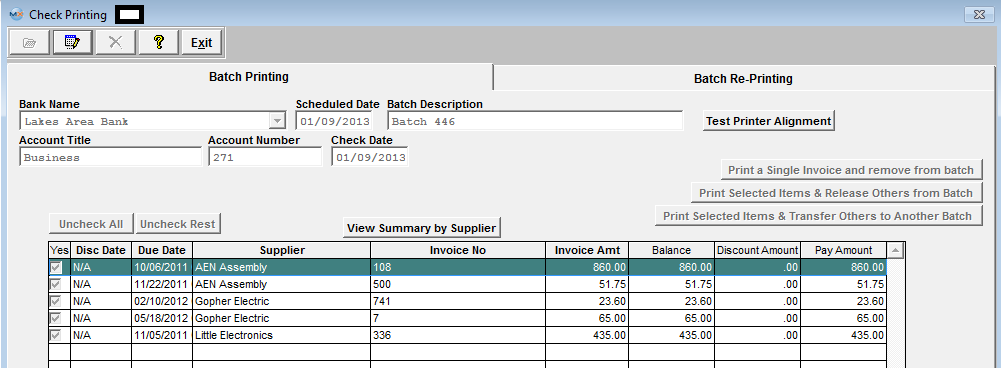 Check Printing Screen field definitions -- Batch Printing tab:
This is the date that the user has selected for this batch to be paid. The user assigned description pertaining to this batch. The G/L title for this bank. The number that the bank has for this account. The button will uncheck/check all of the checkmarks in the Yes column. Highlight the last item you want to include in this payment, then clicking on this button will uncheck/check the rest of the checkmarks in the Yes column. Depressing this button selection will bring up the following screen:
View Batch Detail field definitions: Summary of Selected Items By Supplier
The name of the supplier to which payment will be made. The name of the institution or business which will appear on the check. The first address line per the Supplier Information setup. The applicable early payment discount amount. The sum of all of the scheduled invoice payments for this batch. Selecting this will return you to the prior screen view. Print Checks
If user receives the following message after depressing the Print Check button:
 This message is displayed when the check that the system is attempting to print would end up being for a negative value. One possible reason would be that the Remit To information between the Invoice and Debit Memo's selected on the Check Batch are different, or blank. Due to this the system would want to create two separate checks, and that could place the Debit Memo on a check by itself. We can not allow checks for negative value. So we suggest that you make sure that all of your Remit To information is properly populated within the Supplier Information module. However, there is a work around if you need to create a check for an Invoice and Debit Memo that have different or Blank Remit To Information, you may process the records through the Check Maintenance module, Record & Print a Check . If the "Remit to Address" printing on the check is different then expected or balnk refer to Article #3342 for further detail.
.
Test Printer Alignment
Print a Single Invoice and remove from batch Choosing this option will allow the user to select just one invoice from a batch and print a check for it. Uncheck any boxes in the Yes column which you DO NOT want to pay. Depress the Print a Single Invoice and remove from batch button. The following will display:
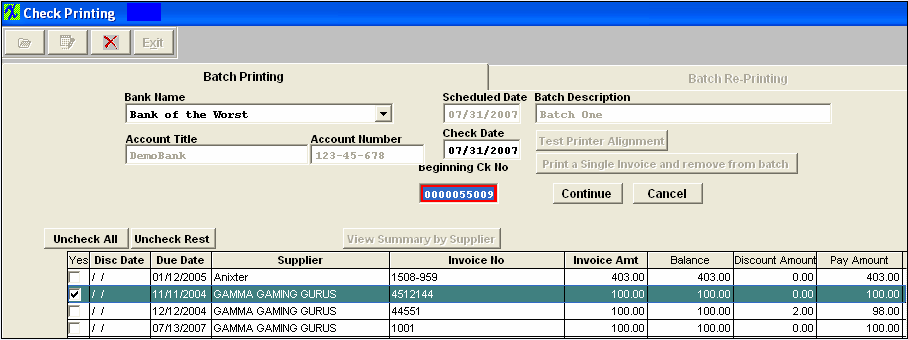 You may enter a different check number than the default if you choose. Depress the Continue button to print the check.
Print Selected items and release others from Batch
Choosing this option will allow the user to select some invoices from a batch and print checks for them. All invoices NOT checked in the Yes box will be released from all scheduling. Uncheck any boxes in the Yes column which you DO NOT want to pay. Depress the Print Selected items and release others from batch button.
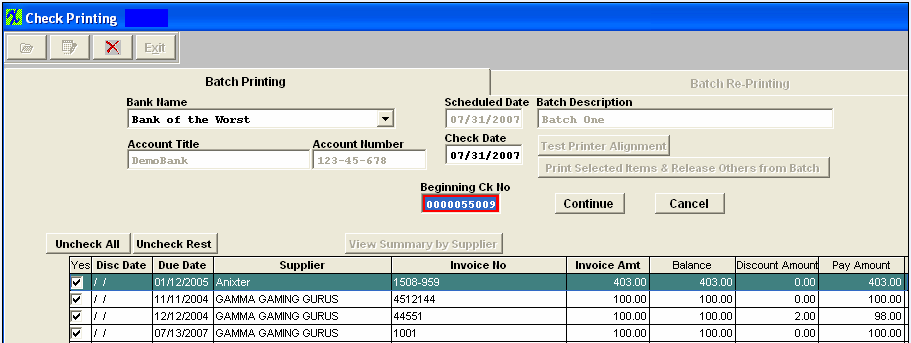 You may enter a different check number than the default if you choose. Depress the Continue button to print the check. Print Selected Items and Transfer Others to Another Batch Choosing this option will allow the user to select some of the invoices from a batch and print checks for them. Additionally, items not selected will be transferred to a newly created batch. After depressing the “Print selected Items and Transfer Others to Another Batch”, the screen below will appear. You will need to enter in the New Batch Description. 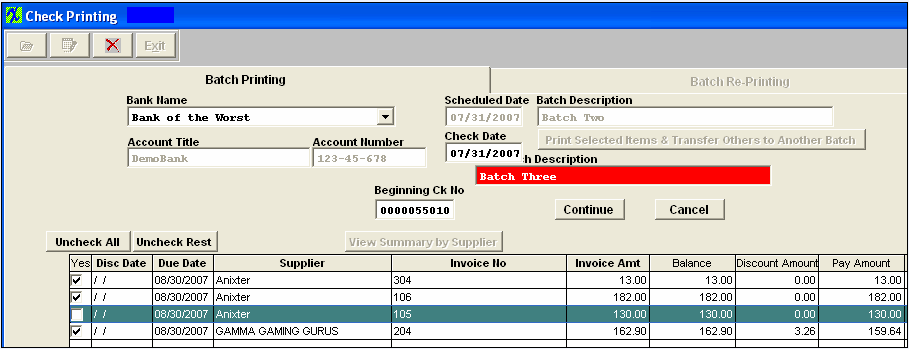 You may enter a different check number than the one displayed if you choose. Depress the Continue button to print the checks.
Next, click on the OK button. Note: that an entirely new batch has been created for the invoices not checked.
Reprint ChecksThe Batch Re-Printing tab is used to re-print checks that got mangled in the printer. 
The following screen will be displayed.
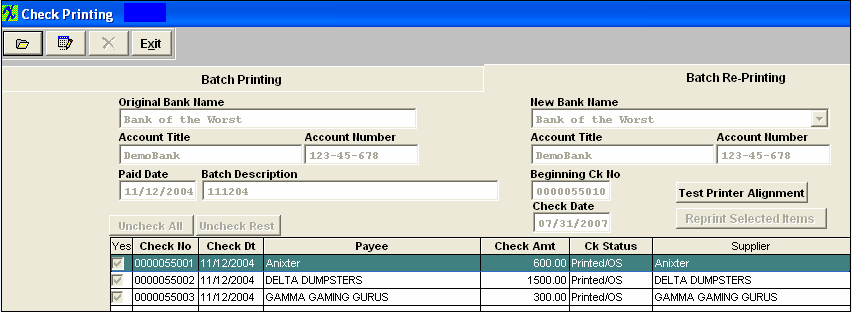 Depress the Edit button. Enter in your password. Check the Yes column at the far left for the checks you wish reprinted. You have the option to change the Check number at this point in time if needed. Depress the Reprint Selected Items button. The new check will go to the printer. The old check number will be voided and will be replaced by the new check number on the Check Register.
|
| 1.1.4.1. Check Forms |
STANDARD xERP CHECK LAYOUT - This layout would be used with blank checks.
 DELUXE FORM DLT104 - This form would be used with Checks purchased from Deluxe Business Checks & Forms. NOTE: When you switch over to using a new Deluxe Form, please contact ManEx for new layout.
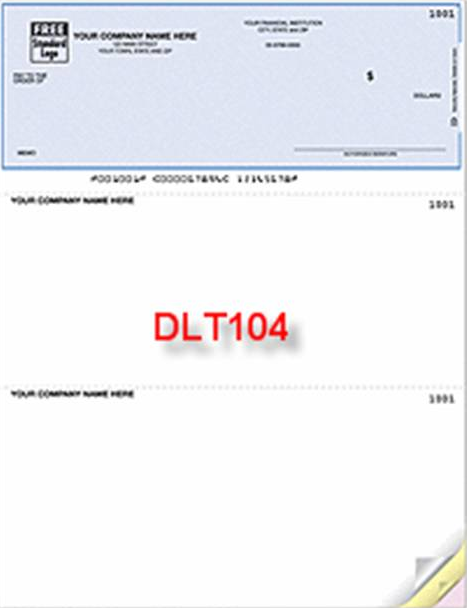 CANADIAN CHECK LAYOUT - This form would be used with Checks purchased from Litho-Quebec JGB Inc. See information below.
 Litho-Quebec JGB Inc. <st1:street w:st="on"><st1:address w:st="on">545 Delmar Ave.
Pointe-Claire, QC
H9R 4A7
514.694.9595
Item number to order from is: 402182 |
| 1.2. Check Maintenance |
| 1.2.1. Record & Print Check | ||||||||||
|
Select the "Check Maintenance" tab and the following screen will be displayed. This tab is used to record a manual check, to void a check or to re-print a single check.  Note: To reprint batches of checks, see the Batch Re-Printing procedures.
If the "Record and Print a Check" radio is selected, the user will be able to issue a check via the printer and at the same time, record it. This is especially useful for COD non-inventory orders.
Note: For COD orders involving inventory, please refer to the Pre-Pay Supplier procedures.
Enter in the amount of the check. If you wish to add a Check Note, select the Check Note button, depress the Edit button, enter in your note, depress the Save button, then depress the Exit button. Depress the Add Item button located at the bottom of the screen. Enter in the Item Number, Description. Enter an Invoice number that may or maynot exists in the AP Aging. When the Invoice number is entered the Invoice Amount, Balance, and General Ledger Number will fill in automatically and user can make the needed changes to the Disc Taken and Amt Paid. If the Check is NOT against an Invoice user will need to assign a GL number to the record.
Once the Check amount and the detail total are the same, the Save button will enable. You may enter a different check number than the one displayed if you choose. 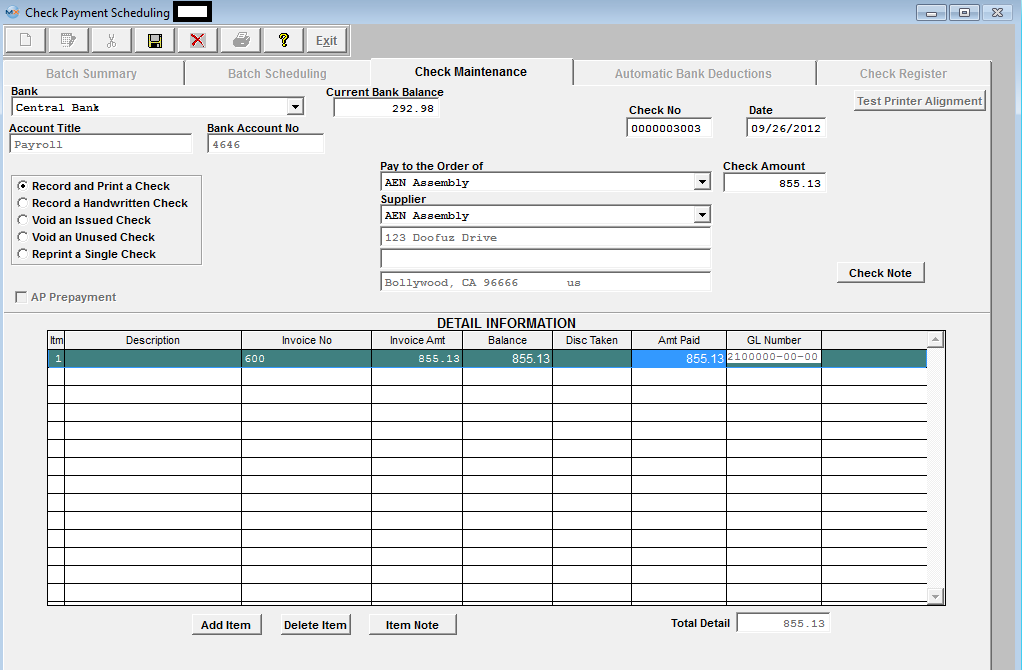 Depress the Save button and the following check format selection will appear:
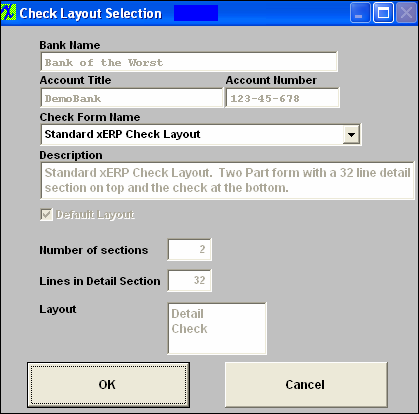 Click on the down arrow to select the desired layout; There are three types of Check Forms to select from: Standard xERP Check Layout; Deluxe Form DLT104; or Canadian Check Layout. See Article #4657 for further information on the check forms.
 Once the selection has been made, depress the "OK" button and the check will go to the printer and will also record.
|
| 1.2.2. Record a Hand Written Check | ||||||||||
|
Select the "Check Maintenance" tab and the following screen will be displayed. This tab is used to record a manual check, to void a check or to re-print a single check.
If the "Record a Handwritten Check" radio is selected, the user will have already manually hand written a check. This function will only record the check, it will not print out a check.
Enter in the Amount. The system will default to the next check number, but the user may highlight the check number field and enter in a different number if desired. Depress the Add Item button. Enter in the Item number, if the invoice is applicable to an existing invoice already in the Accounts Payable Aging, enter in the Invoice number exactly as it exists in the AP Aging. Then the remaining fields will automatically update.
Enter in the Amt Paid and depress the Save Record button. The AP Aging will update and the check will be recorded. If the check you are attempting to record does not apply to an existing record in the AP Aging. After depressing the Add Item button, you will need to enter in an Item number, Description, Invoice Amt, Amt Paid, and a GL Number. Once the Total Detail equals the Amount field, the system will allow you to save the record.
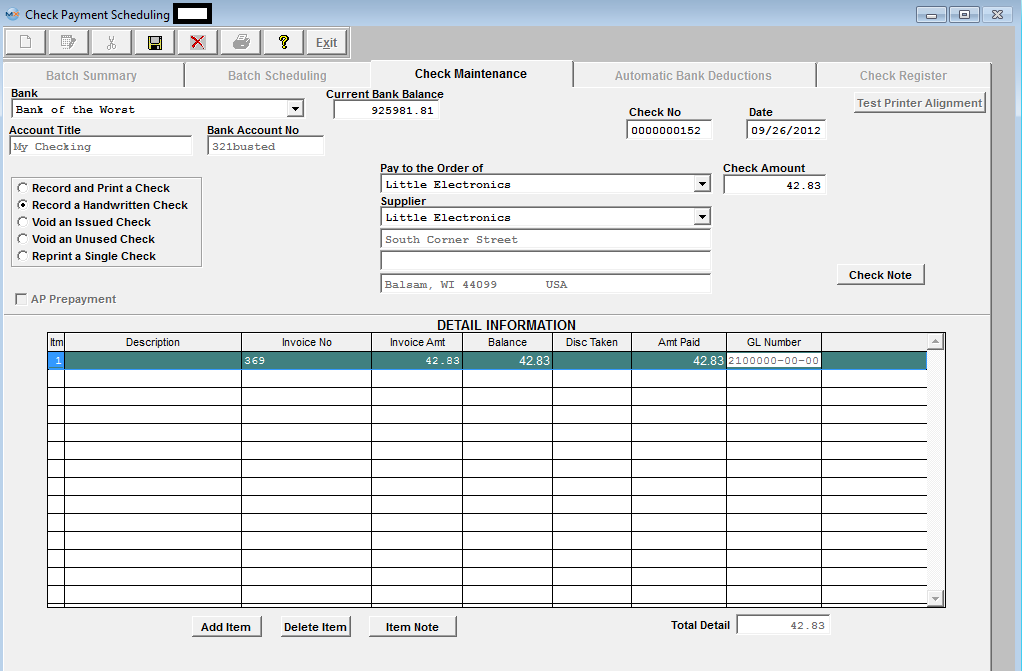 |
| 1.2.3. Void an Issued Check | ||||
|
Select the "Check Maintenance" tab and the following screen will be displayed. This tab is used to record a manual check, to void a check or to re-print a single check.
If the "Void an Issued Check" radio is selected, the user may void any un-cleared outstanding check. If the check has been recorded as cleared or reconciled the following message will be displayed and check cannot be voided:  Enter the check number you wish to void. All of the associated data will appear, as detailed below.
Depress the Save button. You will receive the following message to confirm that you want to void the check:
Select "Yes" and the check will be voided by displaying a negative Check Amount, shown in the red box below. NOTE: The date will be reverted back to the original check date upon Save.
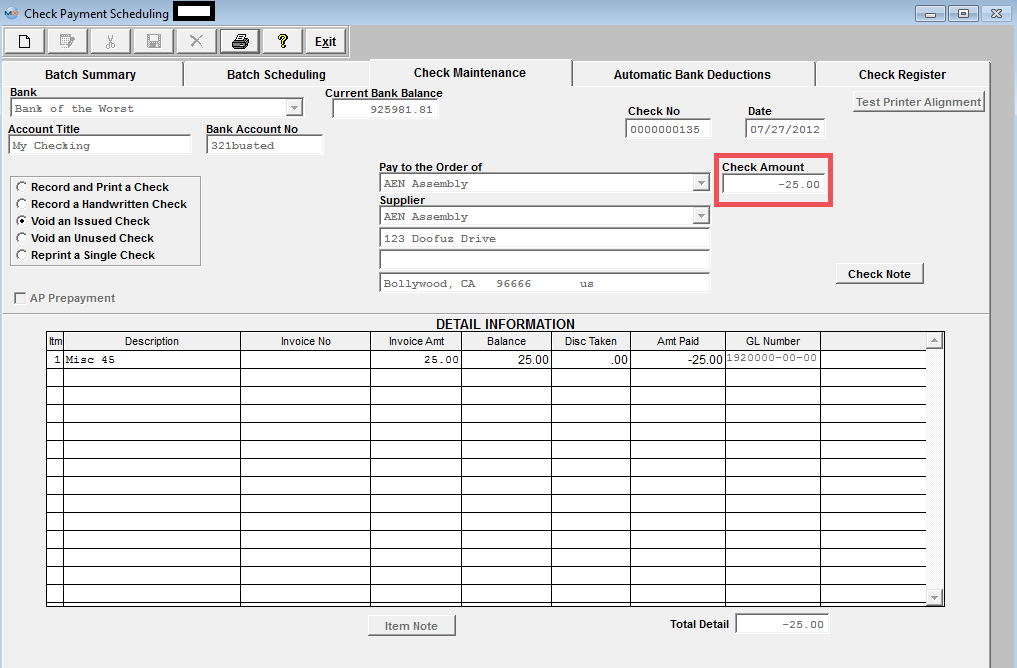 |
| 1.2.4. Void an Unused Check | ||||
|
Select the "Check Maintenance" tab and the following screen will be displayed. This tab is used to record a manual check, to void a check or to re-print a single check.
If the "Void an Unused Check" radio is selected, the user may void a check which had never been paid through or entered in the system as a manual check recording. Enter the check number you wish to void.
 Depress the Save button. You will receive the following message to confirm that you want to void the check:
Depress the Yes button. The check will be recorded as Void in the Check Register. |
| 1.2.5. Reprint a Single Check | ||
|
Select the "Check Maintenance" tab and the following screen will be displayed. This tab is used to record a manual check, to void a check or to re-print a single check.
Note: To reprint batches of checks, see the Batch Re-Printing procedures. To get started, depress the Add button. Type in your password. Depress the down arrow next to the Bank field. Select the appropriate bank.
If the "Reprint a Single Check" radial is selected, the user will be able to void out and reprint a single check. Enter the old check number into the field, the system will automatically fill in all of the rest of the information. The system will prompt for the next check number. The user may highlight the check number field and type in another number if needed. Once the Check amount and the detail total are the same, the Save button will enable.
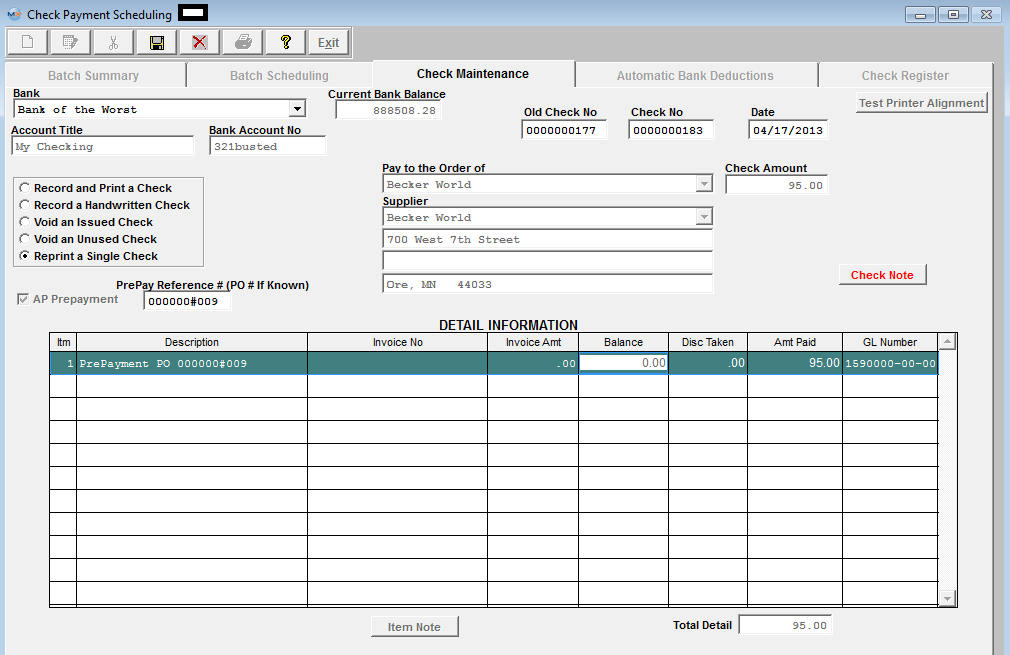 Depress the Save button. The check will go to the printer and will also record. |
| 1.3. Automatic Bank Deduction |
| 1.3.1. Add a New Automatic Bank Deduction |
|
Select the "Automatic Bank Deductions" tab and the following screen will be displayed. This tab is used to record a manual check, to void a check or to re-print a single check.  Depress the Add button. Enter in your password. Enter the original number of payments, the date of the first deduction then select the bank. Enter the payment amount, the day of the month for the deduction and a description of the deduction.
 Depress the Add Item button. Type in the Item Number, a description of the line item, the line item amount and the General Ledger number. Note: if you don’t know the G/L number, place the cursor in the G/L field and hit the Enter key twice. This will bring up the following: 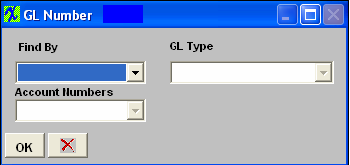 Depress the arrow next to the Find By field.
Scroll up or down until the appropriate G/L range is found. Then depress the down arrow next to the Account Numbers field. The following selection for the posting account will appear:
Select the account. Depress the OK button.
 Note that the Payment Amt and the Total Detail must be equal before the save button will be available.
Depress the Save button to save changes, depress the Abandon Changes button to abandon changes. NOTE: Once this record is saved it will not be editable, if changes are needed to the record you will be required to close the existing record and create a new one accordingly. For further explanations see Article #2328.
|
| 1.3.2. Edit an Automatic Bank Deduction |
Editing a Automatic Bank Deduction
You may only make a change to an un-saved Automated Bank Deduction. If it’s been saved, you are able to edit the Note information only. The reason for this is that these records are the source for the automatic deductions frm the bank account and if we did allow any of the items to be changed user would have no audit trail. (For example if you have an automatic deduction from bank account for payment of an auto loan of $500 on the 2nd of each month and system allowed you to change the amount from $500 to $400 for an office equipment loan in July, you would have no audit trail back for the $500 auto loan). So instead of editing a record, the user may change the status to Closed and then add a new automatic bank deduction with the desired features. For further information see Article #2328.
|
| 1.3.3. Close an Automatic Bank Deduction |
To close out an automatic bank deduction. Highlight the pertinent deduction and depress the Close button.
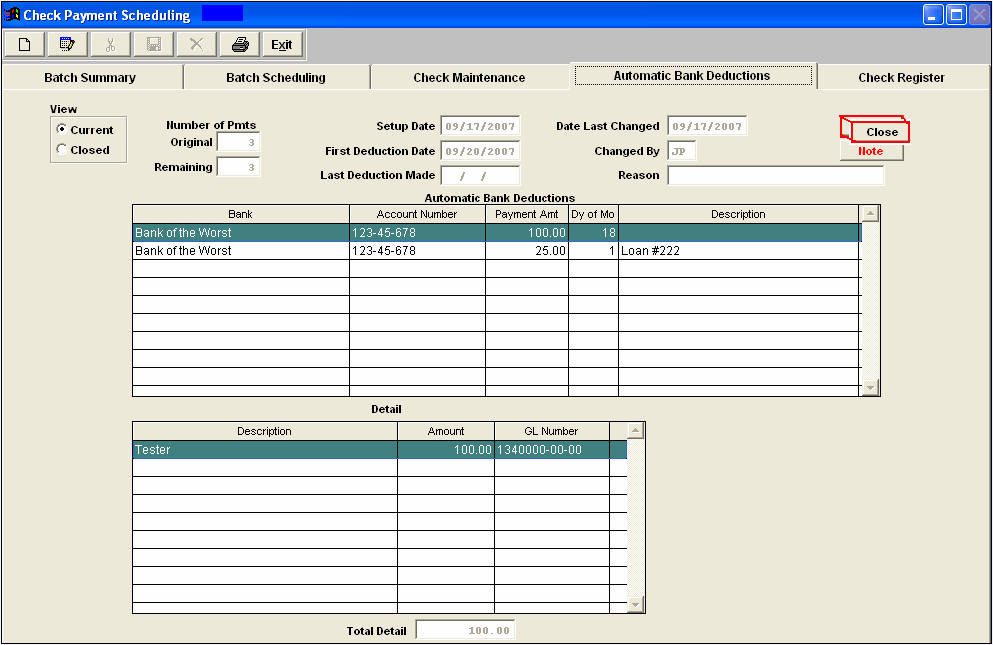 Type in your password. Depress the Save button to save the changes, depress the Abandon Changes button to abandon the changes. To view the deduction you’ve closed, click on the Closed radial and the screen view will update.
 |
| 1.4. Check Register |
| 1.4.1. Create a Check Register | ||||||||||
Depressing the Check Register tab will bring up the following screen:
To design the check register display and the applicable print out, depress the down arrow next to the Bank field. Select the pertinent bank. The account number and account name will automatically fill in .If you are interested in only one specific payee, depress the down arrow next to the Payee filed and select the desired payee. If you want to view a specific date range, type in the Date Range From and To. If you are interested in a range of check numbers, type in the first and the last check number into the Check Number Range fields. Determine the Check status you desire by click on the appropriate radial:
All transaction status types will display in the detail. Only checks marked off as Cleared in the Bank Reconciliation module will display. Both un-cleared and cleared checks will display. Once you have all of the criteria selected, hit the Display button:
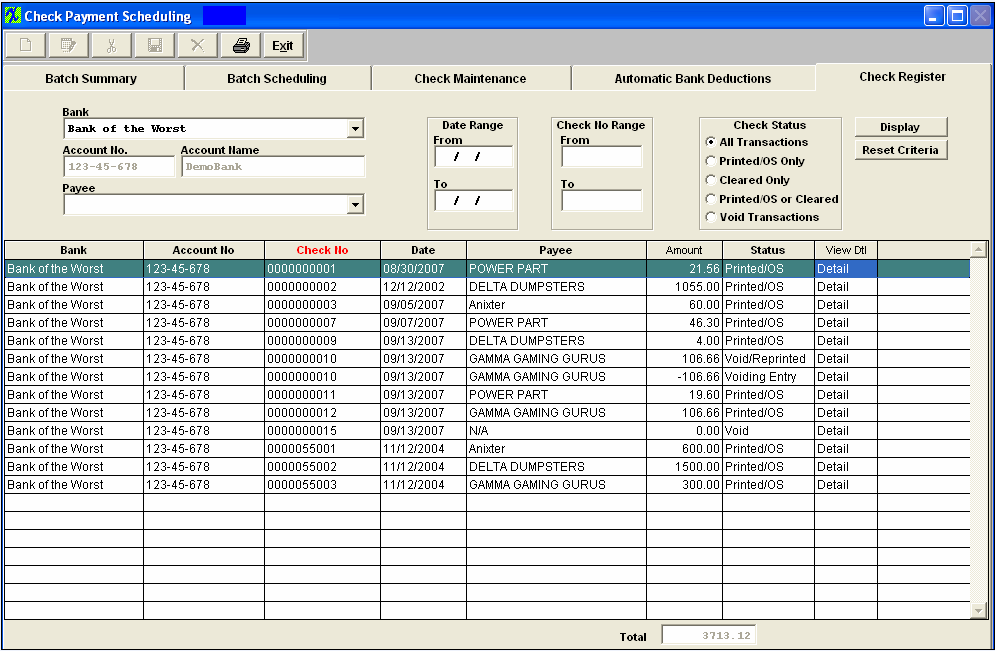 Once the display is showing on the screen, you may sort by Bank, Account Number, Check Number, Date, Payee or Status by clicking on the column header: To view the detail of any line item, click on the Detail column on the far right hand side.The following screen will display:
To further view any notes pertaining to the Check, depress the Check Note button. To view any note specific to the individual line item, depress the Item Note button. Hit Exit to return to the main screen. To reset the selection criteria, depress the Reset Criteria button. Then re-design the display. |
| 1.5. How To Pre-Pay A Supplier | ||
The following screen will appear:
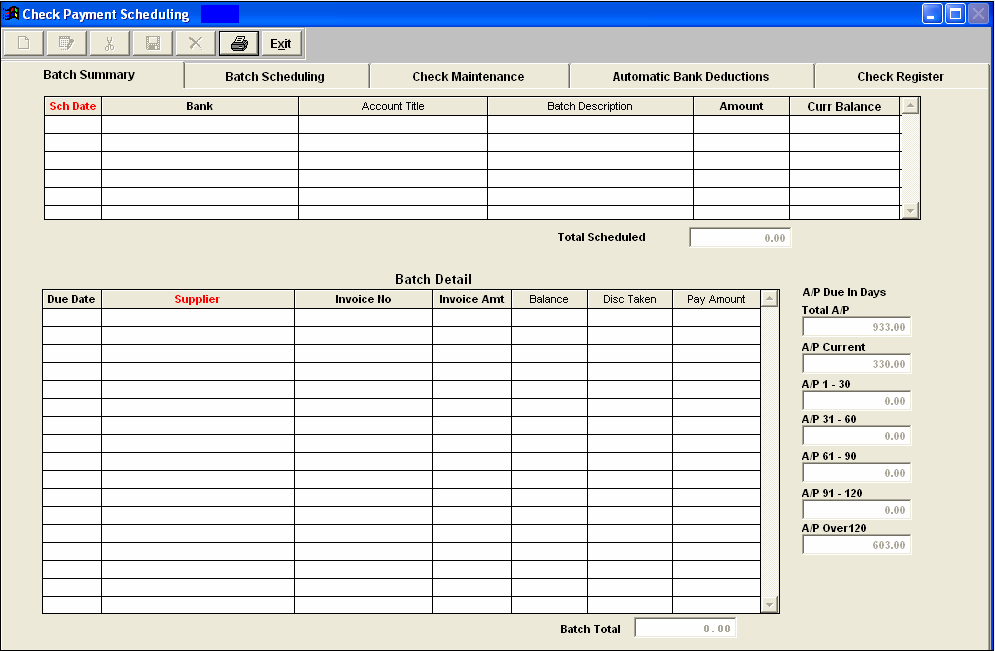 Depress the Check Maintenance tab. User can enter all of the information for a manual check on this screen.
  Once the AP Prepayment box is check, an additional box will appear for user to enter a Prepay Reference number (if applicable). We suggest that you populate it with Prepayment Reference # or Purchase order if known) NOTE: A Prepay GL number must be setup in the GL Acct Setup screen and the Purchase AP Setup in order to use this option.
Check number and date will default in, but may be edited: Select the Supplier (payee) from the pulldown and enter the Check amount. The "Add Item" button at the bottom of the detail info screen will become available: 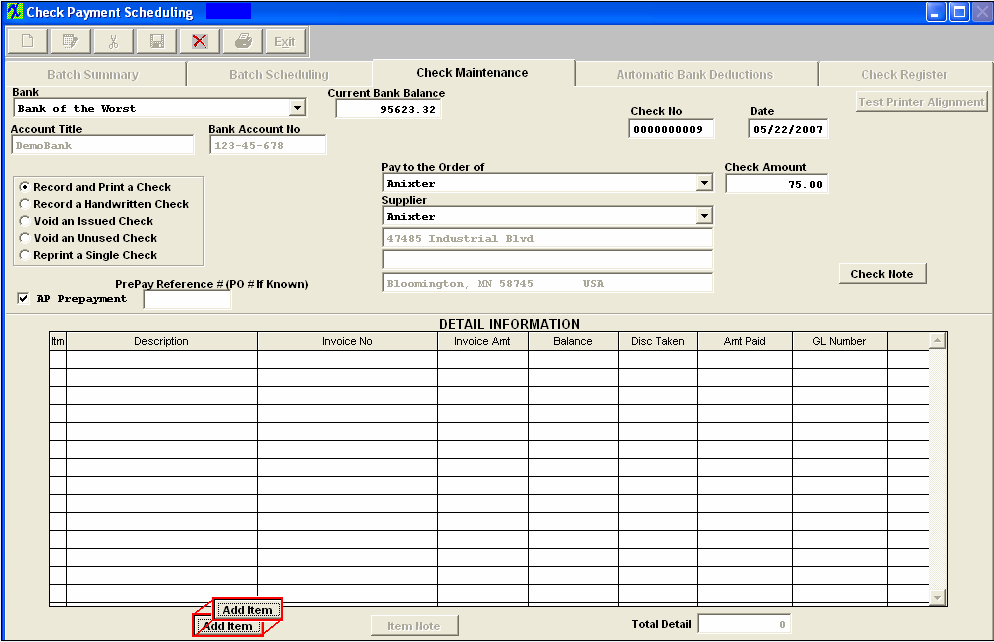 Depress this button and the detail information will default in, enter a GL number: 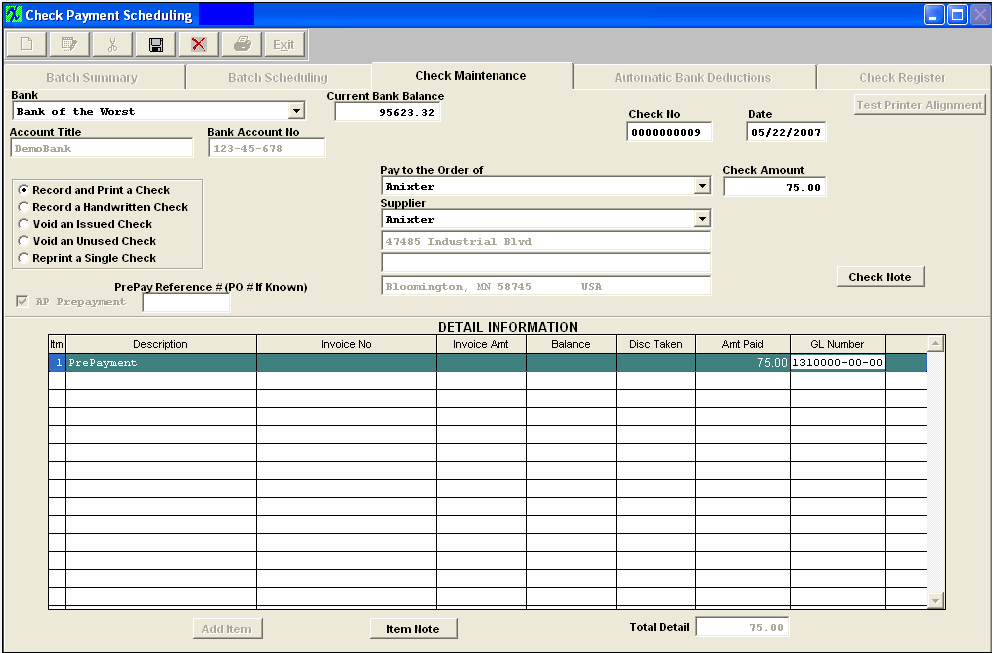 Save Record and print check. The entry will record as follows:  |

